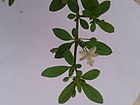Note: This is a project under development. The articles on this wiki are just being initiated and broadly incomplete. You can Help creating new pages.
Difference between revisions of "Mollugo cerviana"
(→Uses) |
|||
| Line 8: | Line 8: | ||
==Chemical Composition== | ==Chemical Composition== | ||
| − | Plant contains flavone-c-glycoside orientin, vitexin. Use - Stomachic, aperient and antiseptic. Flower and tender shoots diaphoretic and febrifuge. Root boiled in oil for application in gout and rheumatism. | + | Plant contains flavone-c-glycoside orientin, vitexin. Use - Stomachic, aperient and antiseptic. Flower and tender shoots diaphoretic and febrifuge. Root boiled in oil for application in gout and rheumatism. <ref name="chemical composition"/> |
| − | <ref name="chemical composition"/> | ||
==Common names== | ==Common names== | ||
| − | {{Common names|kn= | + | {{Common names|kn=Kaage purale gida, Kaage purule gida|ml=Parpataka|sa=Grishmasundara, Parpataka|ta=Citalacatti2, Citam|te=Parpaataka, Parpadagum|hi=Chirimorio, Chiriya ro khet|en=}} |
| − | |hi= | ||
==Properties== | ==Properties== | ||
| Line 35: | Line 33: | ||
==Identification== | ==Identification== | ||
===Leaf=== | ===Leaf=== | ||
| − | {{Leaf|Simple| | + | {{Leaf|Simple|Linear in shape|1.5 centimeters long, Arranged in whorls around the stem}}<ref name="Leaf"/> |
===Flower=== | ===Flower=== | ||
| − | {{Flower|Unisexual|2 millimeters long,| | + | {{Flower|Unisexual|2 millimeters long,|Whitish||The inflorescence is a loose umbel of tiny flowers. Petal-like sepals}} |
| − | |||
===Other features=== | ===Other features=== | ||
| Line 50: | Line 47: | ||
==How to plant/cultivate== | ==How to plant/cultivate== | ||
| − | The plant is often regarded as a troublesome weed in the areas in which it occurs. | + | The plant is often regarded as a troublesome weed in the areas in which it occurs.<ref name="How to plant/cultivate"/> |
| − | <ref name="How to plant/cultivate"/> | ||
==Commonly seen growing in areas== | ==Commonly seen growing in areas== | ||
| Line 65: | Line 61: | ||
==References== | ==References== | ||
<references> | <references> | ||
| − | <ref name="chemical composition">[https://herbs.indianmedicinalplants.info/index.php/sanskrit-names-of-plants/44-2012-02-24-07-34-36/365-mollugo-cerviana#:~:text=Chemical%20Constituents%2D%20Plant%20contains%20flavone,application%20in%20gout%20and%20rheumatism. | + | <ref name="chemical composition">[https://herbs.indianmedicinalplants.info/index.php/sanskrit-names-of-plants/44-2012-02-24-07-34-36/365-mollugo-cerviana#:~:text=Chemical%20Constituents%2D%20Plant%20contains%20flavone,application%20in%20gout%20and%20rheumatism. Chemical composition]</ref> |
| − | <ref name="Leaf">[https://en.wikipedia.org/wiki/Mollugo_cerviana | + | <ref name="Leaf">[https://en.wikipedia.org/wiki/Mollugo_cerviana Identification]</ref> |
| − | <ref name="How to plant/cultivate">[http://tropical.theferns.info/viewtropical.php?id=Mollugo+cerviana | + | <ref name="How to plant/cultivate">[http://tropical.theferns.info/viewtropical.php?id=Mollugo+cerviana Cultivation]</ref> |
</references> | </references> | ||
Revision as of 12:25, 24 June 2020
Mollugo cerviana is a species of flowering plant known by the common name threadstem carpetweed. It can be found on most continents growing as a weed in many types of dry, sandy habitat types.
Contents
- 1 Uses
- 2 Parts Used
- 3 Chemical Composition
- 4 Common names
- 5 Properties
- 6 Habit
- 7 Identification
- 8 List of Ayurvedic medicine in which the herb is used
- 9 Where to get the saplings
- 10 Mode of Propagation
- 11 How to plant/cultivate
- 12 Commonly seen growing in areas
- 13 Photo Gallery
- 14 References
- 15 External Links
Uses
Uterine stimulant antiseptic, Febrifuge, Stomach ache.
Parts Used
Chemical Composition
Plant contains flavone-c-glycoside orientin, vitexin. Use - Stomachic, aperient and antiseptic. Flower and tender shoots diaphoretic and febrifuge. Root boiled in oil for application in gout and rheumatism. [1]
Common names
| Language | Common name |
|---|---|
| Kannada | Kaage purale gida, Kaage purule gida |
| Hindi | Chirimorio, Chiriya ro khet |
| Malayalam | Parpataka |
| Tamil | Citalacatti2, Citam |
| Telugu | Parpaataka, Parpadagum |
| Marathi | NA |
| Gujarathi | NA |
| Punjabi | NA |
| Kashmiri | NA |
| Sanskrit | Grishmasundara, Parpataka |
| English |
Properties
Reference: Dravya - Substance, Rasa - Taste, Guna - Qualities, Veerya - Potency, Vipaka - Post-digesion effect, Karma - Pharmacological activity, Prabhava - Therepeutics.
Dravya
Rasa
Guna
Veerya
Vipaka
Karma
Prabhava
Habit
Identification
Leaf
| Kind | Shape | Feature |
|---|---|---|
| Simple | Linear in shape | 1.5 centimeters long, Arranged in whorls around the stem |
Flower
| Type | Size | Color and composition | Stamen | More information |
|---|---|---|---|---|
| Unisexual | 2 millimeters long, | Whitish | The inflorescence is a loose umbel of tiny flowers. Petal-like sepals |
Other features
List of Ayurvedic medicine in which the herb is used
Where to get the saplings
Mode of Propagation
How to plant/cultivate
The plant is often regarded as a troublesome weed in the areas in which it occurs.[3]
Commonly seen growing in areas
Photo Gallery
References
External Links
- [https://ucjeps.berkeley.edu/cgi-bin/get_JM_treatment.pl?5159,5162,5163 Mollugo cerviana
]
- Ayurvedic Herbs known to be helpful to treat Uterine stimulant antiseptic
- Ayurvedic Herbs known to be helpful to treat Febrifuge
- Ayurvedic Herbs known to be helpful to treat Stomach ache
- Herbs with Flower used in medicine
- Herbs with Roots used in medicine
- Herbs with common name in Kannada
- Herbs with common name in Hindi
- Herbs with common name in Malayalam
- Herbs with common name in Tamil
- Herbs with common name in Telugu
- Herbs with common name in Sanskrit
- Habit - Herb
- Index of Plants which can be propagated by Seeds
- Herbs that are commonly seen in the region of Garden area
- Herbs
- MOLLUGINACEAE



